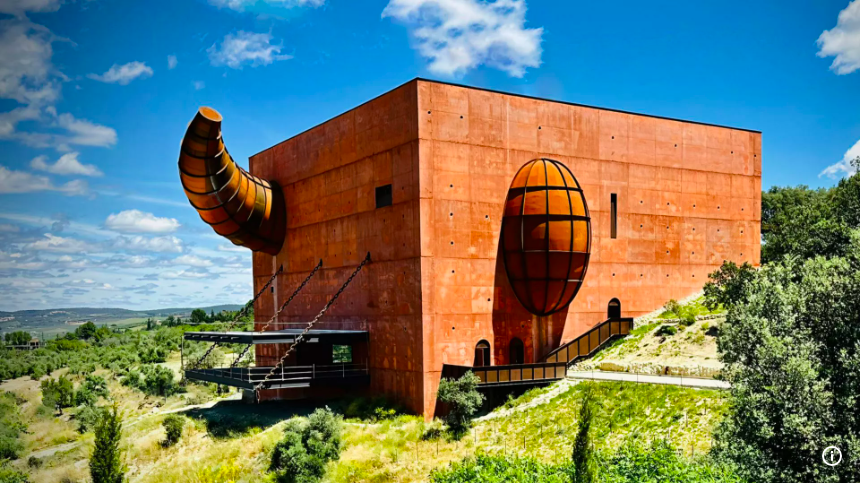Inside Philippe Starck’s Surreal Olive Oil Mill: LA Almazara Blends Art, Architecture, and Andalusian Culture
Quote from Alex bobby on April 13, 2025, 7:17 AM
LA Almazara: Philippe Starck’s Surreal Olive Oil Cathedral in Andalusia
In the heart of southern Spain’s olive country, just outside the cliff-perched town of Ronda, a massive red cube juts out from the landscape like a surrealist sculpture. This is LA Almazara, a one-of-a-kind olive oil mill, museum, and architectural wonder created by legendary French designer Philippe Starck — a passion project 15 years in the making.
Though it functions as an olive oil production facility, LA Almazara is far from industrial. Every element of the structure is steeped in symbolism. One facade displays a colossal bull’s horn — a nod to Andalusia’s famed bullfighting heritage — while another wall features a half-olive, representing the region’s agricultural lifeblood. A Phoenician eye, glaring and grand, watches over the estate’s 26 hectares of olive groves.
Inside, the mill plunges visitors into deliberate darkness. Starck uses shadow and silence to heighten attention, where symbols — a miniature bull, a crypt-like atmosphere, a giant sword representing the estoque — evoke the emotional and cultural tensions of the region. There’s also a tribute to Abbas Ibn Firnas, the 9th-century Ronda-born inventor who dreamed of flight long before da Vinci.
The complex hosts what may be the only museum in the world dedicated solely to olive oil. Visitors learn surprising facts: Citroën’s iconic DS used olive oil in its mechanics; Titanic’s kitchens were stocked with it for elite passengers. Despite olive oil’s gourmet status, it makes up just 1.28% of the world’s edible oil — far behind palm and soy.
The functioning mill lies beneath the main structure, where harvested olives enter through a large metal tube, are crushed, and turned into LA Organic’s award-winning Extra Virgin Olive Oil. Visitors can watch the process unfold, then head upstairs to the Greenhouse for tastings. The experience is almost ritualistic — smell, swill, swallow — and each oil tells a different story through aroma and aftertaste.
For those seeking full immersion, a nearby Cortijo offers luxurious lodging with Stack-designed furnishings. The five-bedroom country house mixes rustic charm with surrealist design — curved chairs resembling bull horns, a cozy fireplace surrounded by hand-picked kindling, and an eclectic library. The price tag? €2,500 per night.
Despite the opulence, the purpose remains grounded. LA Almazara draws tourists, foodies, architects, and filmmakers (like House of Cards’ Robin Wright) not just for its beauty, but for its vision: a temple to nature, culture, and sustainable living.
Interview with Philippe Starck: The Mind Behind LA Almazara
Euronews Culture sat down with Philippe Starck to understand the vision behind LA Almazara — and how it reflects his lifelong mission of “poetic functionalism.”
What inspired LA Almazara?
Starck: It’s a love letter to Andalusia, Ronda, and olive oil. The surrealism is rooted in the land — this dry, dramatic place, where a town like Ronda seems to have been cleaved in two by God himself. I wanted the architecture to communicate without words — a surrealist language that invites everyone in. At the same time, the design is highly functional. The olive oil process is precise, delicate, and fast. LA Almazara ensures that from tree to bottle, it’s done with purity and speed.
Why the bull symbolism, especially as a known animal rights advocate?
Starck: I abhor bullfighting. It’s a cruel and unequal fight. But it’s also a deep part of Andalusian identity. The building acknowledges that — not to glorify, but to provoke thought. The red cube, the horn, the sword — these are symbols of tradition and struggle. Inside, it’s like a Pandora’s box of Andalusian culture, meant to stir your emotions and make you question.
What deeper meanings are hidden inside LA Almazara?
Starck: Every element speaks. The building is a crypt to olive oil — cool, dark, respectful. There’s a massive headless figure, a pipe that never exits, a metal chimney that welcomes fire. Above hangs a model of one of the first flying machines — a tribute to Abbas Ibn Firnas. These are riddles to awaken your imagination. It’s not just a building. It’s a conversation with your subconscious.
You mentioned your neurodivergent. How does that influence your design?
Starck: I live in another world — not the one most people inhabit. My brain sees things differently. LA Almazara reflects that “elsewhere.” It’s radical, out-of-scale, a bit mad. But it opens a door to a new way of thinking, of seeing. That’s what I hope people take away: a spark, a moment of wonder.
What legacy do you want to leave behind?
Starck: I want to be a light in the fog. A pilot. I’ve always tried to see what’s coming and offer better solutions — democratic design, ecological products, responsible living. Whether it’s Good Goods in 1996 or LA Organic now, my goal is to help people live with more dignity and less waste. And yes, maybe leave behind a few beautiful, surreal buildings that make people feel something real.
Final Thoughts
LA Almazara is not just a mill. It’s a myth made concrete — part sanctuary, part sculpture, and entirely Starck. It’s a place where past and future, nature and architecture, logic and dream all meet. For visitors, it’s more than a tasting tour — it’s a journey into the surreal soul of southern Spain.

LA Almazara: Philippe Starck’s Surreal Olive Oil Cathedral in Andalusia
In the heart of southern Spain’s olive country, just outside the cliff-perched town of Ronda, a massive red cube juts out from the landscape like a surrealist sculpture. This is LA Almazara, a one-of-a-kind olive oil mill, museum, and architectural wonder created by legendary French designer Philippe Starck — a passion project 15 years in the making.
Though it functions as an olive oil production facility, LA Almazara is far from industrial. Every element of the structure is steeped in symbolism. One facade displays a colossal bull’s horn — a nod to Andalusia’s famed bullfighting heritage — while another wall features a half-olive, representing the region’s agricultural lifeblood. A Phoenician eye, glaring and grand, watches over the estate’s 26 hectares of olive groves.
Register for Tekedia Mini-MBA edition 17 (June 9 – Sept 6, 2025) today for early bird discounts. Do annual for access to Blucera.com.
Tekedia AI in Business Masterclass opens registrations.
Join Tekedia Capital Syndicate and co-invest in great global startups.
Register to become a better CEO or Director with Tekedia CEO & Director Program.
Inside, the mill plunges visitors into deliberate darkness. Starck uses shadow and silence to heighten attention, where symbols — a miniature bull, a crypt-like atmosphere, a giant sword representing the estoque — evoke the emotional and cultural tensions of the region. There’s also a tribute to Abbas Ibn Firnas, the 9th-century Ronda-born inventor who dreamed of flight long before da Vinci.
The complex hosts what may be the only museum in the world dedicated solely to olive oil. Visitors learn surprising facts: Citroën’s iconic DS used olive oil in its mechanics; Titanic’s kitchens were stocked with it for elite passengers. Despite olive oil’s gourmet status, it makes up just 1.28% of the world’s edible oil — far behind palm and soy.
The functioning mill lies beneath the main structure, where harvested olives enter through a large metal tube, are crushed, and turned into LA Organic’s award-winning Extra Virgin Olive Oil. Visitors can watch the process unfold, then head upstairs to the Greenhouse for tastings. The experience is almost ritualistic — smell, swill, swallow — and each oil tells a different story through aroma and aftertaste.
For those seeking full immersion, a nearby Cortijo offers luxurious lodging with Stack-designed furnishings. The five-bedroom country house mixes rustic charm with surrealist design — curved chairs resembling bull horns, a cozy fireplace surrounded by hand-picked kindling, and an eclectic library. The price tag? €2,500 per night.
Despite the opulence, the purpose remains grounded. LA Almazara draws tourists, foodies, architects, and filmmakers (like House of Cards’ Robin Wright) not just for its beauty, but for its vision: a temple to nature, culture, and sustainable living.
Interview with Philippe Starck: The Mind Behind LA Almazara
Euronews Culture sat down with Philippe Starck to understand the vision behind LA Almazara — and how it reflects his lifelong mission of “poetic functionalism.”
What inspired LA Almazara?
Starck: It’s a love letter to Andalusia, Ronda, and olive oil. The surrealism is rooted in the land — this dry, dramatic place, where a town like Ronda seems to have been cleaved in two by God himself. I wanted the architecture to communicate without words — a surrealist language that invites everyone in. At the same time, the design is highly functional. The olive oil process is precise, delicate, and fast. LA Almazara ensures that from tree to bottle, it’s done with purity and speed.
Why the bull symbolism, especially as a known animal rights advocate?
Starck: I abhor bullfighting. It’s a cruel and unequal fight. But it’s also a deep part of Andalusian identity. The building acknowledges that — not to glorify, but to provoke thought. The red cube, the horn, the sword — these are symbols of tradition and struggle. Inside, it’s like a Pandora’s box of Andalusian culture, meant to stir your emotions and make you question.
What deeper meanings are hidden inside LA Almazara?
Starck: Every element speaks. The building is a crypt to olive oil — cool, dark, respectful. There’s a massive headless figure, a pipe that never exits, a metal chimney that welcomes fire. Above hangs a model of one of the first flying machines — a tribute to Abbas Ibn Firnas. These are riddles to awaken your imagination. It’s not just a building. It’s a conversation with your subconscious.
You mentioned your neurodivergent. How does that influence your design?
Starck: I live in another world — not the one most people inhabit. My brain sees things differently. LA Almazara reflects that “elsewhere.” It’s radical, out-of-scale, a bit mad. But it opens a door to a new way of thinking, of seeing. That’s what I hope people take away: a spark, a moment of wonder.
What legacy do you want to leave behind?
Starck: I want to be a light in the fog. A pilot. I’ve always tried to see what’s coming and offer better solutions — democratic design, ecological products, responsible living. Whether it’s Good Goods in 1996 or LA Organic now, my goal is to help people live with more dignity and less waste. And yes, maybe leave behind a few beautiful, surreal buildings that make people feel something real.
Final Thoughts
LA Almazara is not just a mill. It’s a myth made concrete — part sanctuary, part sculpture, and entirely Starck. It’s a place where past and future, nature and architecture, logic and dream all meet. For visitors, it’s more than a tasting tour — it’s a journey into the surreal soul of southern Spain.
Uploaded files:


